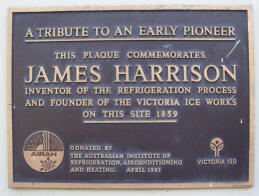A plaque but no statue

Every day, large numbers of backpackers, school groups and tourists in
buses make their way down the street near the Victoria Market on their way
to experience Melbourne and what made it the city it is today. Few notice
the small plaque marking the position of the Victoria Ice Works built by
James Harrison. Those who do are highly unlikely to find the name of James
Harrison in their guide books. Other cities have built statues to people of
lesser importance, but in Melbourne Harrison has to make do with a small
plaque.
James Harrison arrived in Melbourne as a young Scot working in the
printing trade. Long hours of compiling type could be just another tedious
job for many, but it allowed young James to read every word of a wide range
of publications. Romances were all very well, but publications about the
latest scientific theories and how things worked meant you could go home and
try them out. When he first arrived in Sydney his editor was William
a�Beckett whose name now adorns a street nearby the Harrison plaque. When
Harrison arrived in Melbourne he started working for the irascible Johnny
Fawkner, but the young Scot soon wanted to strike out on his own. He set up
the Geelong Advertiser (now just known by the locals as the Addy)
and started working on scientific and engineering ideas. With the arrival of
the gold rush Geelong became a boom town but was mainly exporting gold and
greasy wool with no value added to any product. Victoria had a surplus of
sheep and there were millions in Britain near starving. However meat could
not survive the trip across the equator and sheep were being rendered down
for tallow. Instead of exporting food we were exporting raw material for
making candles.
Harrison had been experimenting with mechanical refrigeration in a hut by
the Barwon River and realised that if he was to take his ideas further he
needed access to the precision engineering available in England but not yet
possible in the fledgling settlement. He set off for England where he
designed and built the first successful refrigeration machinery. On
returning to Geelong he set up the world�s first commercial ice making
plant. He sold ice chests at cost. Long before the inkjet printer industry
he realised that you keep the entry price low and make your money on the
consumables. During his absence, the newspaper business had not been well
managed and together with the expenses incurred in developing his invention
he ended up insolvent and had to sell the newspaper.
Faced with a lack of money and working for an employer in the business he
had founded Harrison stooped to build up his life and business with worn-out
tools. By 1859 he had an ice works in Melbourne while continuing his work as
a writer, Member of Parliament and serving on various citizens� committees.
He knew the mineral boom of the time would not last and was determined to
find a way to transport refrigerated meat to Europe. In the 1870s he fitted
out part of a ship with cooling apparatus to transport 10 tons of meat to
England. Part way into the voyage the cooling brine had irretrievably leaked
away, possibly due to poor workmanship in the tanks, pipings and seals. The
meat and Harrison were ruined.
In England Harrison returned to his trade as a writer providing columns
for The Age in Melbourne while continuing to improve the design and
patents of his refrigeration machinery. By the time he returned to Geelong,
others, building on his pioneering work, had solved the problems of
refrigerated shipboard transport and the economy of Victoria was placed on a
sustainable basis that would serve it well for the best part of a century.
In Florida you can find a statue to a Dr Gorrie for his contributions to
refrigeration. Dr Gorrie never succeeded in making a commercial
refrigeration machine. Harrison, using a different design and sound
engineering principles, did. Dr Gorrie has a statue and was proclaimed one
of Florida' two most distinguished citizens because of his work on
refrigeration � Harrison has a small, much-ignored plaque in Melbourne. In
Geelong, Harrison has a carved bollard, and a very fine one it is. However
in Melbourne, tourists hurry past the Harrison plaque on their way to see
important things.
Harrison, the creator and entrepreneur of one of the most important
inventions of his age, died in Geelong in reduced circumstances. Perhaps his
most telling monument is not the plaque in Melbourne but his tombstone which
reads "one soweth, another reapeth".
|
|
Copyright © 1995 - 2025
White Hat.
|
Other articles in the series Seven Monuments of Melbourne: